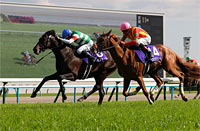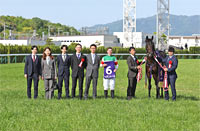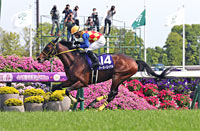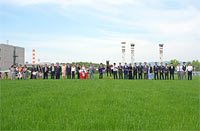Tenno Sho (Spring) (G1) - Data Analysis
Race steeped in tradition that brings together stellar performers and exciting dark horses
In the Tenno Sho (Spring) races since 1984, when the grade system was introduced, only nine of the 35 winners had never finished in the Top 3 of a domestic or overseas G1 race. Incidentally, the nine winners since 2010 all had experience finishing in the Top 3 of a domestic or overseas G1 race. In other words, a solid track record in long-distance races for older horses appears to be an important condition to do well in this race. In the 14 years since 2005, when Trifecta bets were introduced, the Tenno Sho (Spring) produced eight six-figure payouts and two seven-figure payouts. While highly favored runners with strong track records have delivered outstanding performances, poorly favored runners have often risen to the occasion, making this a tough race to call. Let’s now analyze some features shared by successful runners in this race based on results over the last 10 years.
Focus on runners that performed well in major race held since previous year
Of the 30 Top 3 finishers over the last 10 years, 18 had experience finishing in the Top 3 of a “JRA G1 race held since the previous year.” Runners with such a track record achieved a Top 3 ratio of 40.0%. Only three runners belonged to this group in 2018, and they dominated the Top 3. In other words, we should first check runners’ performances in major races held since the previous year. [Table 1]
[Table 1] Performance by experience finishing in the Top 3 of "a JRA G1 race held since the previous year" (last 10 years)
| Experience |
Performance
[1st-2nd-3rd-4th or lower] |
Win ratio |
Top 2 ratio |
Top 3 ratio |
| Yes |
7-7-4-27 |
15.6% |
31.1% |
40.0% |
| No |
3-3-6-120 |
2.3% |
4.5% |
9.1% |
In addition, among runners that had not finished in the Top 3 of “a JRA G1 race held since the previous year” those that had entered a graded race (including an overseas race) last time out and finished in the Top 2 of that race, achieved a Top 3 ratio of 27.0%, a decent outcome. However, other runners only achieved a Top 3 ratio of 2.1%. When comparing runners that have not finished in the Top 3 in a major race held since the previous year, we should carefully take into consideration the grade of their previous race and their finish in that race. [Table 2]
[Table 2] Among runners that had not finished in the Top 3 of "a JRA G1 race held since the previous year," performance by grade of previous race and finish in that race (last 10 years)
Grade of previous race
and finish in that race |
Performance
[1st-2nd-3rd-4th or lower] |
Win ratio |
Top 2 ratio |
Top 3 ratio |
Graded race last time out
with Top 2 finish |
2-3-5-27 |
5.4% |
13.5% |
27.0% |
Non-graded race last time out,
or third-place or lower finish |
1-0-1-93 |
1.1% |
1.1% |
2.1% |
No winners among horses aged 7 and above
Looking at performances by runners over the last 10 years in terms of age, we observe that horses aged 9 or above have produced zero Top 3 finishers, and horses aged 7 or 8 zero winners. This suggests we should lower our expectations of older horses. [Table 3]
[Table 3] Performance by age (last 10 years)
| Age |
Performance
[1st-2nd-3rd-4th or lower] |
Win ratio |
Top 2 ratio |
Top 3 ratio |
| 4 |
3-1-5-36 |
6.7% |
8.9% |
20.0% |
| 5 |
4-4-1-39 |
8.3% |
16.7% |
18.8% |
| 6 |
3-3-2-27 |
8.6% |
17.1% |
22.9% |
| 7 |
0-1-2-18 |
0% |
4.8% |
14.3% |
| 8 |
0-1-0-16 |
0% |
5.9% |
5.9% |
| 9 |
0-0-0-4 |
0% |
0% |
0% |
| 10 |
0-0-0-6 |
0% |
0% |
0% |
| 11 |
0-0-0-1 |
0% |
0% |
0% |
However, looking at runners that had not finished in the Top 3 of "a JRA G1 race held since the previous year" in terms of age, we find that horses aged 7 and above and 4-year-olds were all beaten to 3rd or lower. Among runners that do not clear the condition in Table 1, we should lower our expectations of horses aged 7 and above and 4-year-olds. [Table 4]
[Table 4] Among runners that had not finished in the Top 3 of “a JRA G1 race held since the previous year,” performance by age (last 10 years)
| Age |
Performance
[1st-2nd-3rd-4th or lower] |
Win ratio |
Top 2 ratio |
Top 3 ratio |
| 4 |
0-0-2-24 |
0% |
0% |
7.7% |
| 5 |
1-3-1-33 |
2.6% |
10.5% |
13.2% |
| 6 |
2-0-2-25 |
6.9% |
6.9% |
13.8% |
| 7 |
0-0-1-15 |
0% |
0% |
6.3% |
| 8 |
0-0-0-13 |
0% |
0% |
0% |
| 9 |
0-0-0-3 |
0% |
0% |
0% |
| 10 |
0-0-0-6 |
0% |
0% |
0% |
| 11 |
0-0-0-1 |
0% |
0% |
0% |
Lower expectations of horses with a change of jockey
Of the 30 Top 3 finishers over the last 10 years, 22 were ridden by the “same” jockey as in their previous outing. Conversely, horses ridden by a “different” jockey struggled somewhat with a Top 3 ratio of 10.5%. In other words, we need to discount horses with a change of jockey. [Table 5]
[Table 5] Performance by jockey in previous outing (last 10 years)
| Jockey in previous outing |
Performance
[1st-2nd-3rd-4th or lower] |
Win ratio |
Top 2 ratio |
Top 3 ratio |
| Same |
7-7-8-79 |
6.9% |
13.9% |
21.8% |
| Different |
3-3-2-68 |
3.9% |
7.9% |
10.5% |
In addition, among runners that had not finished in the Top 3 of “a JRA G1 race held since the previous year,” horses ridden by a “different” jockey from the previous outing struggled even more with a Top 3 ratio of 3.2%. This means we should further lower our expectations of runners that contest the race with a different jockey from the previous outing and do not clear the condition in Table 1. [Table 6]
[Table 6] Among runners that had not finished in the Top 3 of “a JRA G1 race held since the previous year,” performance by jockey in previous outing (last 10 years)
| Jockey in previous outing |
Performance
[1st-2nd-3rd-4th or lower] |
Win ratio |
Top 2 ratio |
Top 3 ratio |
| Same |
1-3-6-60 |
1.4% |
5.7% |
14.3% |
| Different |
2-0-0-60 |
3.2% |
3.2% |
3.2% |
Strong performance by runners starting in the inner brackets
Looking at performances by runners over the last 10 years in terms of bracket number, we observe that runners starting out in brackets "1, 2" achieved a comparatively strong Top 3 ratio of 30.0%. This suggest that runners starting out in the inner brackets may have a slight advantage in the race [Table 7]
[Table 7] Performance by bracket number (last 10 years)
Bracket
number
|
Performance
[1st-2nd-3rd-4th or lower] |
Win ratio |
Top 2 ratio |
Top 3 ratio |
| 1 |
5-1-1-13 |
25.0% |
30.0% |
35.0% |
| 2 |
1-2-2-15 |
5.0% |
15.0% |
25.0% |
| 3 |
1-1-1-17 |
5.0% |
10.0% |
15.0% |
| 4 |
1-0-2-17 |
5.0% |
5.0% |
15.0% |
| 5 |
0-0-0-20 |
0% |
0% |
0% |
| 6 |
2-2-2-14 |
10.0% |
20.0% |
30.0% |
| 7 |
0-2-1-24 |
0% |
7.4% |
11.1% |
| 8 |
0-2-1-27 |
0% |
6.7% |
10.0% |
| 1, 2 |
6-3-3-28 |
15.0% |
22.5% |
30.0% |
| 3-8 |
4-7-7-119 |
2.9% |
8.0% |
13.1% |
In addition, among runners that started out in “brackets 3-8” and contested a JRA race in their previous outing, those that were ranked “2nd or lower” in their estimated time over the final three furlongs in their previous race struggled with a Top 3 ratio of 7.3%. When comparing runners that start in brackets 3 or above, we should check the closing times in their previous race. [Table 8]
[Table 8] Among runners that started in brackets “3-8” and contested a JRA race in their previous outing, performance by ranking in terms of estimated time over final three furlongs in that race (last 10 years)
Ranking by estimated time
over final three furlongs in
previous outing |
Performance
[1st-2nd-3rd-4th or lower] |
Win ratio |
Top 2 ratio |
Top 3 ratio |
| 1st |
3-3-3-16 |
12.0% |
24.0% |
36.0% |
| 2nd or lower |
1-4-3-101 |
0.9% |
4.6% |
7.3% |
Position when passing 4th corner in previous race also an important factor
The last 10 winners all contested a JRA race in their previous outing and were positioned “7th or higher” when passing the 4th corner in that race. Conversely, runners that were positioned “8th or lower” when passing the 4th corner in their previous race struggled with a Top 3 ratio of 9.4%. When comparing the lead-up races of this year’s runners, we should check their positions when passing the 4th corner in such races. [Table 9]
[Table 9] Among runners that contested a JRA race in their previous outing, performance by position when passing 4th corner in previous race (last 10 years)
Position when passing 4th
corner in previous race |
Performance
[1st-2nd-3rd-4th or lower] |
Win ratio |
Top 2 ratio |
Top 3 ratio |
| 7th or higher |
10-7-7-96 |
8.3% |
14.2% |
20.0% |
| 8th or lower |
0-3-2-48 |
0% |
5.7% |
9.4% |
Seek out the winner!
Focus on runners with more positives
The last six winners all had experience finishing in the Top 3 of “a JRA G1 race held since the previous year.” Other shared features were that they were all 6 years old or younger, and were positioned 4th or higher when passing the 4th corner in their previous race. Runners clearing many of the conditions outlined in Table 1, Table 3, and Table 9 should therefore be regarded as leading contenders. [Table 10]
[Table 10] Winners' "highest finish in 'JRA G1 race held since previous year,'" "age," and "position when passing 4th corner in previous race" (last 6 years)
| Year |
Winner |
Highest finish in JRA G1 race held
since previous year |
Age |
Position when passing 4th
corner in previous race |
| 2013 |
Fenomeno |
2012 Tenno Sho (Autumn) 2nd, etc. |
4 |
4th |
| 2014 |
Fenomeno |
2013 Tenno Sho (Spring) 1st |
5 |
3rd |
| 2015 |
Gold Ship |
2014 Takarazuka Kinen 1st |
6 |
2nd |
| 2016 |
Kitasan Black |
2015 Kikuka Sho (Japanese St. Leger) 1st |
4 |
1st |
| 2017 |
Kitasan Black |
2017 Osaka Hai 1st, etc. |
5 |
2nd |
| 2018 |
Rainbow Line |
2017 Tenno Sho (Autumn) 3rd |
5 |
4th |
(Masaya Ibuki)
|


















